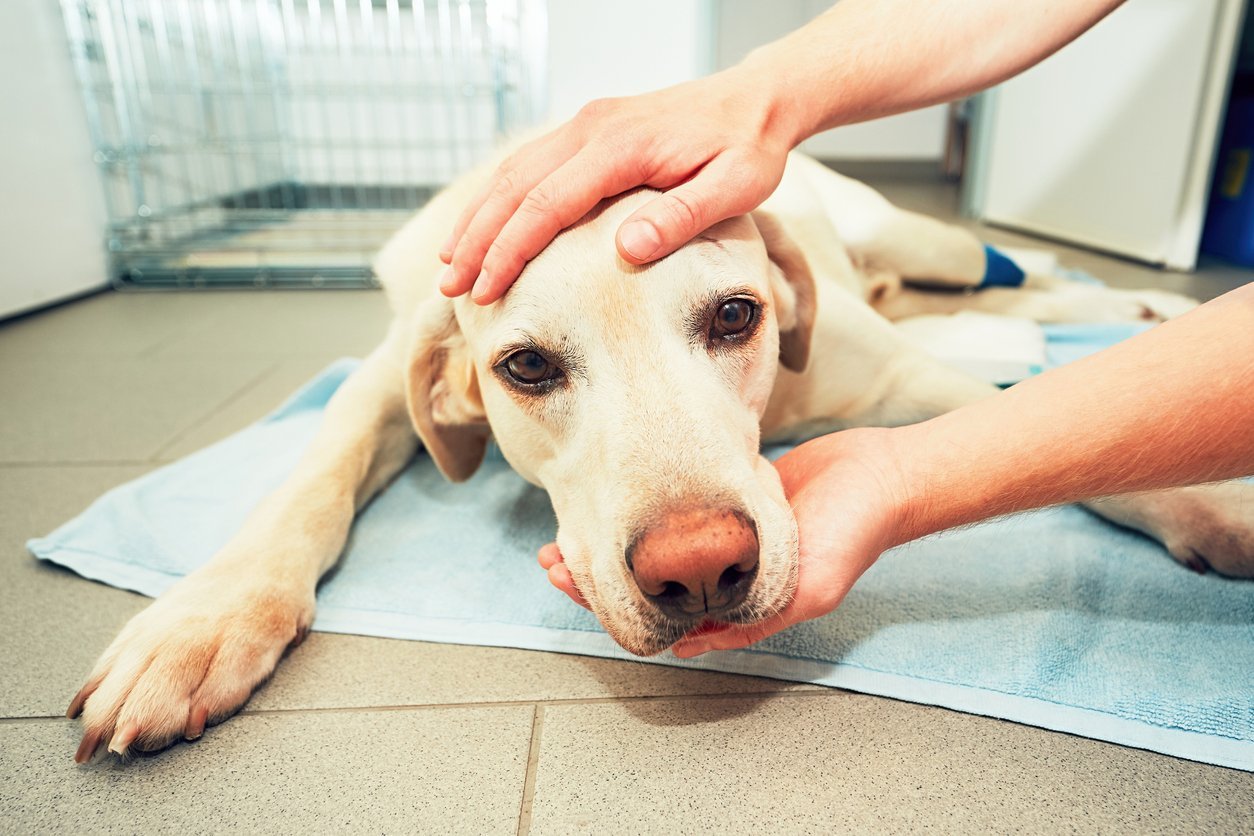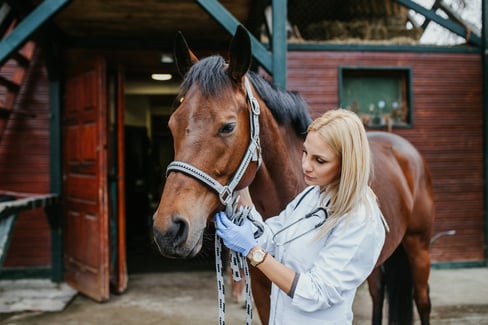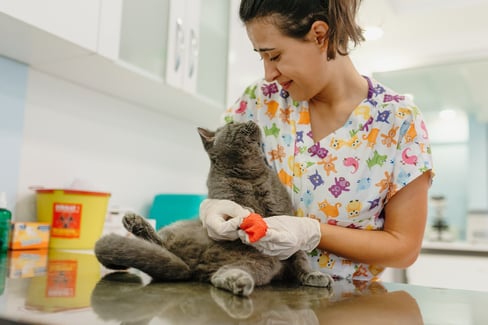Table of Contents
Not sure if your dog has Cushing’s syndrome?
Just want to learn more about how to treat your dog's condition?
This post is here to help.
Cushing’s syndrome in dogs, which is also often misspelled as Cushing or Cushings syndrome, is a condition that affects the dog's body in multiple ways and is caused by different kinds of dysfunction in your pup’s endocrine system.
This dog's health concern can be difficult to diagnose, especially in the early stages, but the earlier you have it diagnosed, the easier it is to manage.
In this blog, we'll cover everything you need to know about the diagnosis, treatment, and management of Cushing’s syndrome in dogs, so they can experience a better outcome in the long run.
Cushing Syndrome in Dogs Explained
You may have heard of Cushing’s Syndrome in humans but are wondering, “what is Cushing’s syndrome in dogs?” The disease is very similar and affects many different mammals. Cushing’s disease in horses and Cushing’s syndrome dog back legs are not uncommon, but it is a fairly rare diagnosis in cats.
Cushing's syndrome in dogs is a condition that affects the endocrine system. Endocrine organs secrete hormones directly into the blood. They work together in systems to regulate many body functions such as metabolism, growth and development, and reproduction.
The adrenal gland is an organ located just above the kidneys that produce hormones that help balance body functions and control inflammatory or allergic responses.
Check out the location of this important little gland in the diagram below.
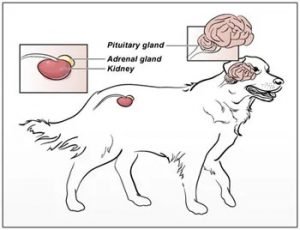
The most critical of the substances controlled by the adrenal gland is cortisol, sometimes called cortisone. Its most important role in managing stress by reducing inflammation caused by tissue damage associated with chronic stressors such as pain.
Cortisol also helps:
- Regulate digestion
- Support energy levels
- Influence blood sugar levels
- Promote healing after injury or illness
- Help maintain blood pressure at optimal levels
When there are imbalances of cortisol or other hormone production from either the pituitary gland or adrenal gland, it can have a profound effect on all systems throughout your dog’s body which can lead to serious health problems if they go untreated for long periods of time. This is especially true for an old dog with Cushing’s syndrome, as they can be more susceptible to serious outcomes from Cushing’s.
Dogs with this condition can also develop dog arthritis in their joints—especially those that bear weight, such as their knees. That’s why it may seem like your playful pup is ‘lazy’, suddenly having little energy for walks or other types of exercise. They may be reluctant to get up from resting positions or even jump up onto furniture like they used to do thanks to Cushing’s syndrome dog back leg effects, which leads owners to believe there is something wrong with their pet's mobility when in fact, it simply becomes too painful for them to jump up!
Stages of Cushing's Syndrome in Dogs
Cushing's syndrome in dogs is a serious health condition. When the adrenal glands produce excess cortisol, it can put your dog at risk of several illnesses, as well as liver damage and kidney disease.
Knowing the symptoms of Cushing's Syndrome in dogs and the stages of the disease can help you prevent your dog’s illness from progressing into more serious conditions.
Dogs with Cushing’s Syndrome undergo three stages:
- Early stage
- Mid-stage
- Late stage
Early Stages of Cushing’s Syndrome in Dogs
The onset of Cushing’s syndrome in dogs can be a long and slow process. The first signs of Cushing’s syndrome in dogs are increased thirst and urination.
You might notice having to refill your dog's water dish more often, or your pup is scratching at the back door more to go outside. When a well-trained dog starts to have accidents in the house, many assume it is because of old age or urinary tract infections, but it could also be a sign of Cushing’s syndrome.
If you notice increased thirst, urination, and other early-stage Cushing's syndrome symptoms in dogs, you should schedule a visit with your veterinarian.
Early stages of Cushing’s syndrome symptoms in dogs include:
- Increased appetite and weight gain
- Painting more than usual
- Hair loss on mid-section
- Thin skin that bruises easily
- Recurring ear and eye infections
- Changes in behaviour, primarily aggression
Mid Stages of Cushing’s Syndrome in Dogs
As Cushing’s Disease in dogs progresses, many dogs develop muscle weakness. Signs of muscle weakness include difficulty doing ordinary tasks like rising from lying down, climbing stairs, jumping, or getting into the car.
Muscle weakness may also cause dogs with mid-stage Cushing’s syndrome to appear pot-bellied. This is due to increased fat in the abdominal organs and the muscles in the abdomen getting weaker.
Late Stages of Cushing’s Syndrome in Dogs
It’s very sad to witness, but during the late and final stages of Cushing’s syndrome in dogs, you’ll notice rapid weight gain and a significant decrease in energy and activity. Diabetes is a common secondary condition that comes with the late stages of Cushing’s syndrome in dogs.
As your dog reaches the final stages, you will notice a loss in appetite and weight loss from muscle deterioration. The dog becomes very weak, and it is hard for them to move around. They will likely be in pain and discomfort.
At this time, you should prepare to say your goodbyes and work with your vet to provide palliative care so your pup can be comfortable in their final days.
Here are a few things you can do to make your pet as comfortable as possible during the final stages of Cushing’s syndrome in dogs:m
- Monitor their symptoms: report any changes to your veterinarian; they may be able to provide medication to ease their pain.
- Create a comfortable environment: Designate a separate area away from noises with comfortable bedding for your dog to rest.
- Replenish water dishes: symptoms of Cushing’s syndrome include increased thirst, so ensure that your dog always has water available. Getting a pet fountain with a high capacity is a good solution.
- Give nutritious meals: Decreased appetites mean every meal counts.
- Maintain a gentle exercise routine: Short walks help with decreased muscle tone and joint mobility.
Types of Cushing's Syndrome in Dogs
Cushing’s syndrome in dogs can be caused by a few different factors, and depending on the cause, your vet will administer appropriate care for their needs.
There are three different types of Cushing’s syndrome in dogs:
- Pituitary-dependent Cushing's Disease (PDCD)
- Adrenal-dependent Cushing's Disease (ADCD)
- Iatrogenic Cushing's Syndrome in Dogs
Let’s get into the paw-ticulars of each of these forms of Cushing syndrome in dog back legs.
Pituitary-dependent Cushing’s Disease
The first cause or type of Cushing syndrome in dogs you should be aware of is pituitary-dependent Cushing’s disease.
This is the most common culprit of the condition, with 85% to 90% of all Cushing’s disease in dogs being caused by pituitary-dependent Cushing’s disease. It happens when there is a tumour in the pituitary gland that causes the dysfunction to occur in the first place. As the tumour grows, it kicks the pituitary gland into high gear, causing it to overproduce ACTH, which leads to the overproduction of cortisol and all the unpleasant side effects of Cushing syndrome in dogs.
As you might guess, the size of the tumour impacts the severity of the disease. The larger the tumour grows in the pituitary gland, the more it can wreak havoc on your poor pup’s well-being, eventually developing neurologic signs.
Adrenal Cushing's Syndrome in Dogs
Less common is adrenal Cushing's syndrome in dogs, accounting for the remaining 10% to 15% of Cushing’s cases in dogs.
This is what happens when a tumour develops in the adrenal gland. Different Cushing's syndrome symptoms in dogs begin to appear as these tumours grow.
Adrenal Cushing's syndrome in dogs can cause two types of tumours:
- Malignant or carcinoma
- Benign or adenoma
Surgical removal will cure a benign tumour, alongside good management with your vet, and give your pup years of life back. Surgical removal of malignant tumours may help for some time, but the outlook is much less promising. Working with your vet to develop a treatment plan that works for both the form of Cushing’s syndrome in dogs and the form of the tumours is essential.
Iatrogenic Cushing's Syndrome in Dogs
Iatrogenic Cushing's syndrome in dogs is a kind of side effect of treatment for other health conditions. Medications such as corticosteroids that can be used to treat arthritis and allergies can have the unintended side effect of causing Cushing’s syndrome in your dog.
Since these drugs are sometimes necessary to treat serious conditions, do not stop giving them without your veterinarian’s instruction. If you believe that your dog may have developed Iatrogenic Cushing’s syndrome, contact your vet for guidance on how to proceed with care.
Cushing’s Syndrome Symptoms in Dogs
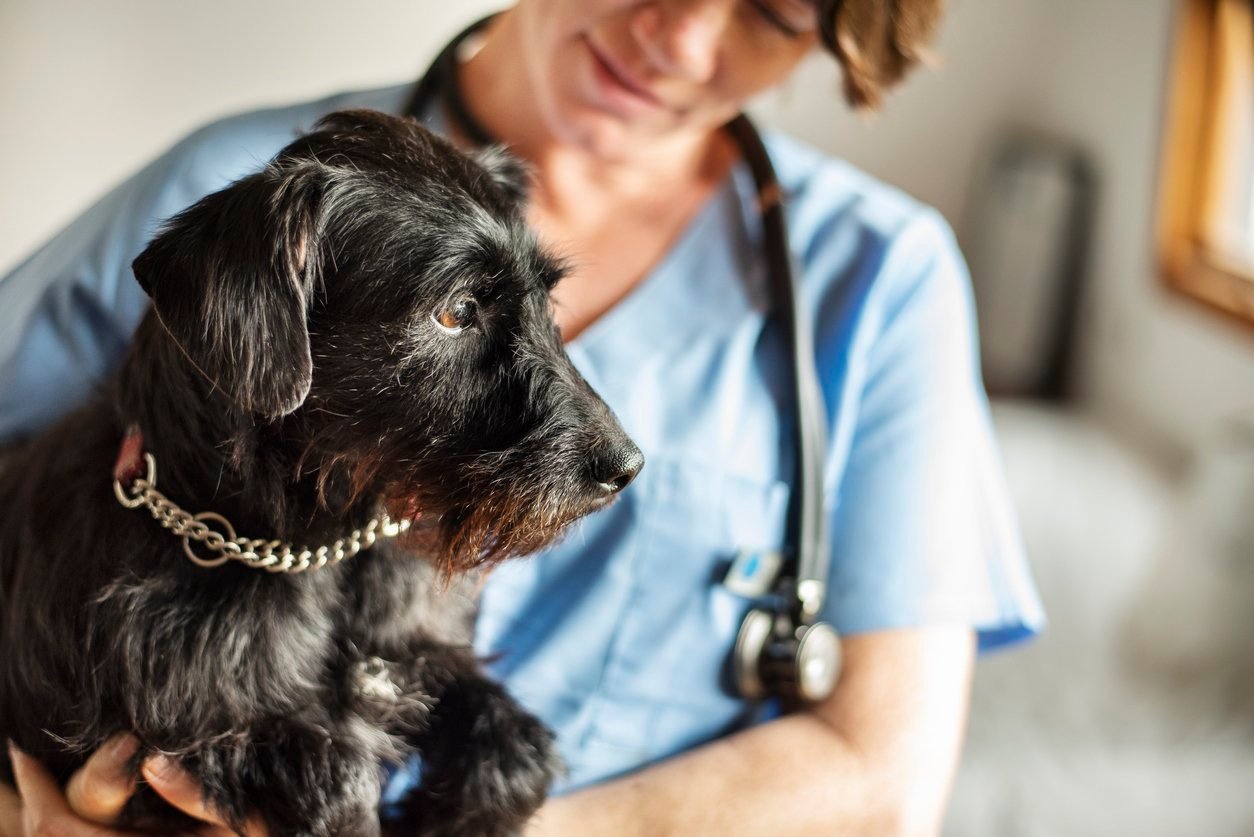
When you’re worried about the signs of a painful condition like Cushing's syndrome in dogs, you need to know exactly what to look for. After all, Cushing’s syndrome in dogs can be tricky to spot in an untrained or, at the very least, unknowledgeable eye.
There are a number of symptoms related to Cushing’s syndrome in dogs that are most telling, especially when spotted together.
Those Cushing’s syndrome in dogs symptoms are:
- Polydipsia (increased thirst)
- Polyuria (increased urination)
- Polyphagia (increased appetite)
That is not to say that it will be an open-and-shut case, though, if you spot these signs. Diabetes and other conditions can also have similar symptoms and effects, so leave the diagnosis to the pros, and pay your vet a visit if you notice Cushing’s Syndrome in dogs symptoms.
Other Cushing's Syndrome in dogs symptoms you can watch for include:
- Lethargy and lack of activity
- Cushing syndrome dog back legs are lame and weak
- Panting excessively
- Skin becomes fragile
- Sudden hair loss and coat shedding
- Regularly or recurring skin infections
- A “pot-bellied” appearance
If you own a few specific breeds, you’ll want to be extra cautious of Cushing’s syndrome in dogs. That’s because they seem to be genetically predisposed to the condition for somewhat unknown reasons.
Breeds prone to Cushing’s syndrome in dogs include:
- Miniature Poodles
- Dachshunds
- Boxers
- Boston Terriers
- Beagles
TL;DR? Keep your eye out for unusual behaviour in your dog and if you have certain breeds of canines that are more prone to Cushing's syndrome in your dog, check in with your vet regularly.
Cushing's Syndrome in Dogs Life Expectancy
According to the American Kennel Club, the average life expectancy of a dog diagnosed with Cushing’s Syndrome dog back legs is two years, with ten percent living beyond four years. However, most dogs diagnosed with Cushing’s Syndrome are senior dogs, so the cause of death is not necessarily related to the disease.
Signs of Cushing Syndrome in Dogs
A diagnosis of Cushing’s syndrome in dogs can be difficult to make as the symptoms can masquerade as other comorbid conditions or something else entirely. Don’t go down the Google rabbit hole; your vet is always the best person to ask how to diagnose Cushing’s syndrome in dogs.
When your vet sees the three P-symptoms we mentioned above (polydipsia, polyuria, polyphagia), they have the trifecta of Cushing’s syndrome that warrants further investigation.
From there, they can do a physical examination and testing that can identify the signs of Cushing’s syndrome in dogs and confirm the diagnosis.
Test for Cushing Syndrome in Dogs
There are a number of diagnostic tests that your vet may use to determine Cushing's syndrome in dogs diagnosis, including those outlined in the table below.
| Test for Cushing Syndrome in Dogs | Description |
| Urinalysis | This test is often the first step in diagnosing Cushing’s Syndrome in dogs as it looks for elevated levels of cortisol in the urine. |
| ACTH Stimulation Test | This test gives information about how well your dog’s adrenal glands are working and can help rule out other diseases that have similar symptoms to Cushing’s Syndrome such as liver disease or diabetes. |
| Low-dose Dexamethasone Suppression (LDDS) | After dogs are given an injection of synthetic cortisol (dexamethasone), their ACTH levels are suppressed, causing a decrease in cortisol levels in their blood. This can detect the presence of Cushing syndrome in dogs. |
Treatment for Cushing's Syndrome in Dogs

The treatment for Cushing’s syndrome in dogs depends on the cause. If your dog has pituitary-dependent Cushing's, you may be able to control the symptoms with medication. Surgery could also cure this form of the syndrome. Medication changes will treat Iatrogenic Cushing’s syndrome in dogs most effectively, while adrenal-dependent Cushing’s syndrome in dogs can be cured by surgery.
In some cases, diet and exercise can help a pup facing Cushing’s feel better and live a more normal life.
Many dogs will need to keep taking medication over the course of their lives, but some may find relief from surgery or lifestyle changes alone. You should talk to your veterinarian about the best options for your dog and your family.
In order to give you an overall picture of the treatment for Cushing’s syndrome in dogs options available, we’ll share an overview of the most common options for how to treat Cushing’s syndrome in dogs.
Treatment Option #1: Surgery
Transsphenoidal hypophysectomy – it’s quite the mouthful.
It’s also the most prevalent form of surgery for treating the adrenal form of Cushing's syndrome in dogs.
This surgery, TSH for shorthand’s sake, is a careful task that removes the tumour inside your pup’s adrenal gland. It’s also the only treatment that can result in a cure if the pituitary tumour is completely removed and is a treatment option at all stages of Cushing syndrome in dogs (where a tumour is present, of course). Research has shown that treatment, when the pituitary mass is small, gives better survival and recurrence rates than those treated later when the pituitary mass is much larger.
Your pup will be restored to its old self in no time after the removal of the tumour, with endocrine signs improving shortly after surgery. The reason for this is TSH decompresses the pressure in the brain and alleviates neurologic symptoms, kind of like releasing the air from a balloon.
Your vet will work closely with you to create a plan for your dog with Cushing’s. Getting early imaging of the pituitary gland for afflicted dogs is crucial to a full examination and can provide valuable insight to determine what is best for your doggo going forward.
If surgery is best for your dog, you will want to take good care to follow all post-op instructions from your vet carefully.
Careful care for Cushing's syndrome in dogs surgery post-op includes:
- Good wound cleaning practices
- Changing bandages daily
- Soft places to rest that are not up a set of stairs
- Feeding medication as directed by your vet
- Supplementing their recovery with extra-strength glucosamine for dogs joint supplement
Feeding a supplement like TRI-ACTA H.A. for dogs after your dog’s surgery can help them speed up recovery and strengthen soft tissues and joints for a healthier life post-operation.
Integricare’s supplement is perfect for Cushing syndrome surgery recovery as it is formulated with 100% pure:
- Glucosamine
- Chondroitin
- MSM
- Hyaluronic acid
Each of these ingredients helps play a role in reducing pain and inflammation, as well as repairing and protecting cartilage, and improving synovial fluid in the joints. This helps your furry family member get back to their normal selves in no time.
TRI-ACTA H.A. for Pets
Our maximum strength formula is optimally designed to accelerate the formation of cartilage, minimize inflammation, expedite the healing process, and improve joint conditions.
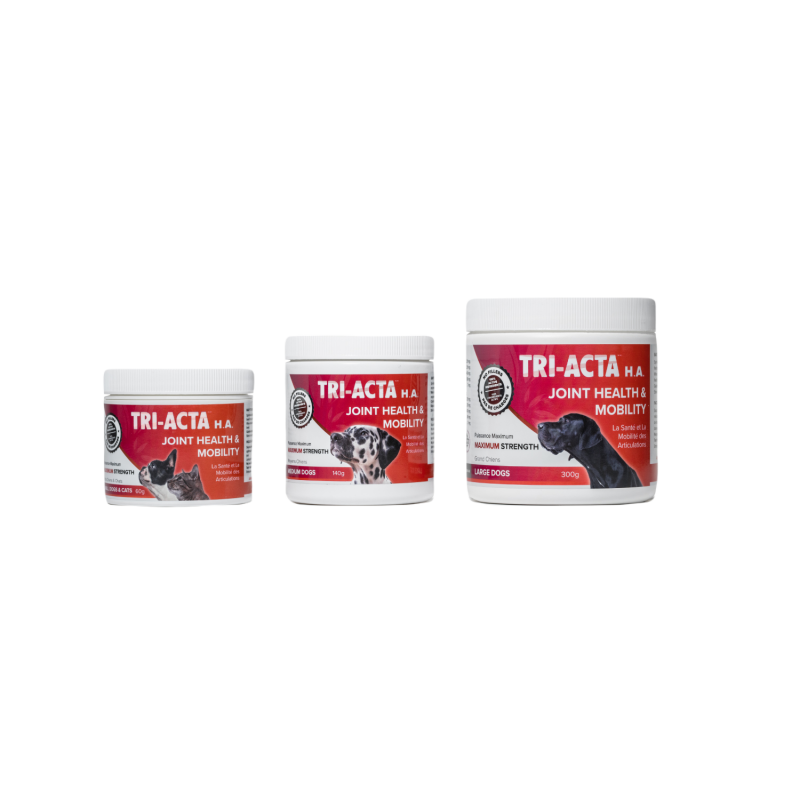
Treatment Option #2: Medication
The good news is that there are medications for Cushing syndrome in dogs that can help manage this disease. These medications can help reduce the amount of cortisol produced by your dog’s adrenal glands and help lower their blood sugar levels.
There are two main types of medications used to treat Cushing syndrome in dogs:
- Antineoplastic agents: Works by slowing growth or reducing the size of the tumour.
- Steroidogenesis inhibitors: Reduce the amount of cortisone produced by the adrenal glands. Also known as Trisolane.
Mitotane is the most common antineoplastic agent used to treat Cushing syndrome in dogs. It works by decreasing cortisol production in the adrenal glands. Just remember to monitor for signs that your pup’s cortisol level has dropped too low, such as reduced appetite, vomiting, and diarrhea. A test is usually performed after 7 to 10 days of treatment to determine whether cortisol levels are dropping sufficiently, and then ongoing blood tests to monitor levels are usually done every 3 to 4 months as part of this treatment. For the disease to remain under control, doses typically need to be increased over time.
Miotane’s adverse side effects can include:
- Vomiting
- Loss of appetite
- Weakness
- Seizures
- Mildly low blood sugar
There are some potential benefits to splitting the daily dose into two equal parts and administering them eight to twelve hours apart, reducing side effects like the ones we listed above.
Treatment Option #3: Regular Vet Visits
In terms of managing lifelong Cushing syndrome or managing it without surgery, regular vet visits are an important part of any treatment plan.
Cushing syndrome in dogs necessitates regular vet visits to check:
- Blood work
- Check response to medication
- Physical exams (checking body condition)
- Inspecting comorbid conditions
Your vet may want you to consider doing targeted radiation therapy to keep tumours small. The effect of radiation therapy is to reduce tumour size and improve neurological signs in dogs. A dog’s life expectancy outcomes are also greatly improved with this treatment. Research shows that dogs with pituitary tumours have a higher overall survival rate after radiotherapy.
Cushing’s Disease Dog Diet
Your vet will probably recommend dietary changes when your dog is diagnosed with Cushing’s syndrome. In addition to suggesting foods that are low in carbohydrates and processed ingredients, you should also look for a diet for dog with cushings that is high in protein, fibre, and essential fatty acids.
Homemade diets, including a raw dog food diet, are ideal because they allow you to control the ingredients used. That being said, it’s important to avoid making any major dietary changes without consulting a veterinarian first because some foods may not be appropriate for dogs with certain conditions or health problems.
Cushing’s Syndrome in Dogs Natural Treatment
While the typical treatments for Cushing’s Syndrome can be very effective, you may be interested in exploring other options for managing your dog’s condition. Fortunately, there are several natural remedies for Cushing’s syndrome in dogs that may help to keep your canine healthy and comfortable.
Cushing Disease Dog Diet
Your vet will probably recommend dietary changes when your dog is diagnosed with Cushing’s Syndrome. In addition to suggesting foods that are low in carbohydrates and processed ingredients, you should also look for food that is high in protein, fibre and essential fatty acids.
Homemade diets like the raw dog food diet are ideal because they allow you to control the ingredients used. That being said, it’s important to avoid making any major dietary changes without consulting a veterinarian or holistic vet first because some foods may not be appropriate for dogs with certain conditions or health problems.
Supplements
Another great option for managing Cushing's syndrome in dogs is utilizing supplements.
Certain natural substances can be used to treat the symptoms of Cushing syndrome. It can make your dog feel more comfortable, however, it will not be able to cure the condition, and is really only a suitable complement to proper medical care from your vet.
A number of nutritional supplements may help to keep your dog healthy while they are being treated for Cushing’s Syndrome.
| Natural Remedies for Cushing’s Syndrome in Dogs Supplements | Description |
| Probiotics1 | Reduces joint inflammation, lowers anxiety, and increases energy, and creates digestive balance to optimize the immune system. |
| Omega-3 fatty acids | Omega 3s can help reduce the glycemic response, helpful for Cushing syndrome-afflicted dogs. |
| Melatonin3 | Provides antioxidants, regulates hormones, and maintains circadian rhythms. As well as help to maintain their coat. |
| Lignans3 | Lingans from the Norwegian spruce tree are converted to enterolactone. Dogs’ bodies use enterolactone as a phytoestrogen. By reducing estrogen production from the adrenal gland, it helps manage Cushing’s disease. |
Always consult your veterinarian before starting a course of vitamins or natural supplements. That way, you can ensure the supplement is in the best interests of your dog.
Q&A
We’ve got answers to the most common questions about Cushing syndrome in dogs so you’re prepared to handle this condition.
What Should Dogs With Cushing’s Eat?
Cushing’s disease dogs need a diet with specific fat, protein, and carbohydrate ratios. Opt for high protein, low fats, and fibre-rich foods. Dogs with Cushing’s should not be fed table scraps, especially not ones that are high in sugar or fat (sorry, bacon lovers). Choosing the right diet can help support their recovery from Cushing’s.
Always consult your vet before making any changes to your pup’s diet, and make sure your whole family is on board with your feeding routines and rules for the better of their health. As much as we love sneaking them a treat once in and while it’s not going to help the Cushing syndrome in dogs’ prognosis.
Conclusion

If your dog is experiencing unusual weight gain, muscle wasting and weakness, or if you have any other concerns about their health, the best thing to do is to bring them to a veterinarian for an exam and diagnosis.
And something else you can do to support their overall health and wellbeing?
Feed them a joint supplement like TRI-ACTA for pets. This formula is designed to alleviate pain and inflammation in joints and soft tissues, as well as protect cartilage from breakdown. And for dogs recovering from surgery, feed TRI-ACTA H.A. for pets for a faster recovery time and more mobile joints.
Find out more pet health and wellness tips on our blog, and check out where to buy TRI-ACTA so you can begin supplementing your dog’s diet for success.
TRI-ACTA H.A. for Pets
Our maximum strength formula is optimally designed to accelerate the formation of cartilage, minimize inflammation, expedite the healing process, and improve joint conditions.

Newsletter Signup
Subscribe to our newsletter to receive the latest news and exclusive offers.
.jpg?height=2000&name=Cliick_Integricare-DISPLAY-REVISEDV2%20(1).jpg)
Proactive & Therapeutic Joint Supplements
When given daily, Integricare joint supplements recover bone and joint injuries faster and help prevent mobility injuries from happening in the first place.

